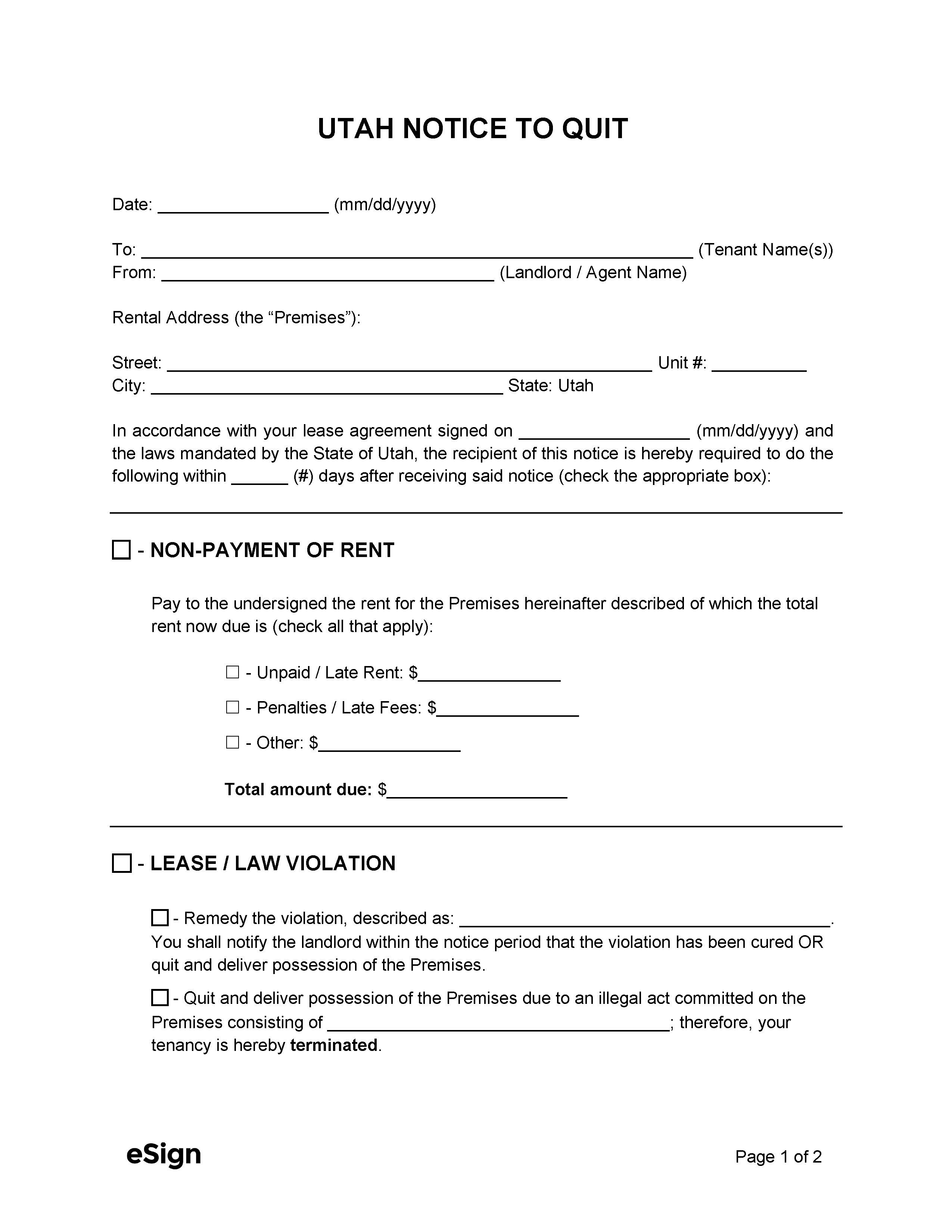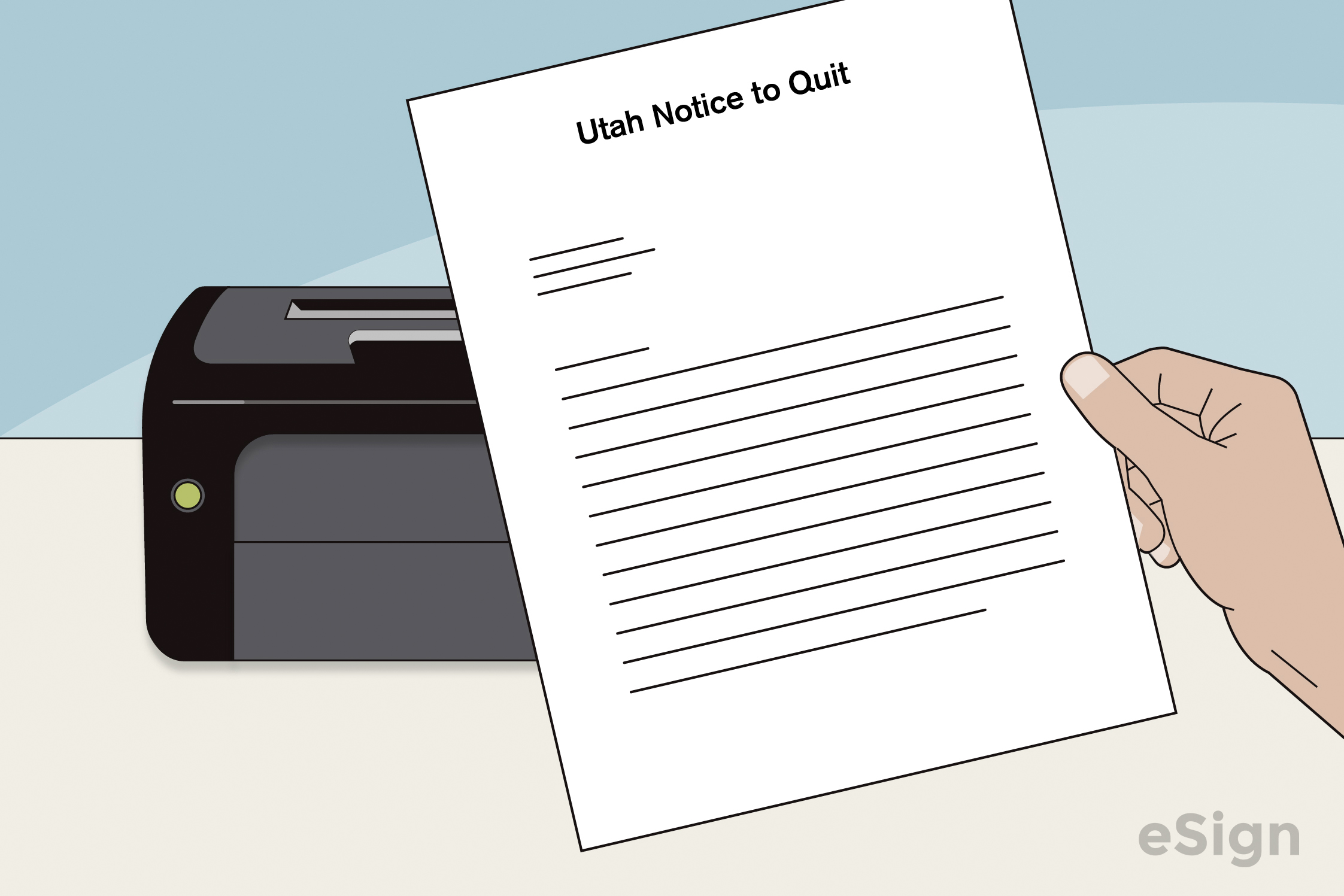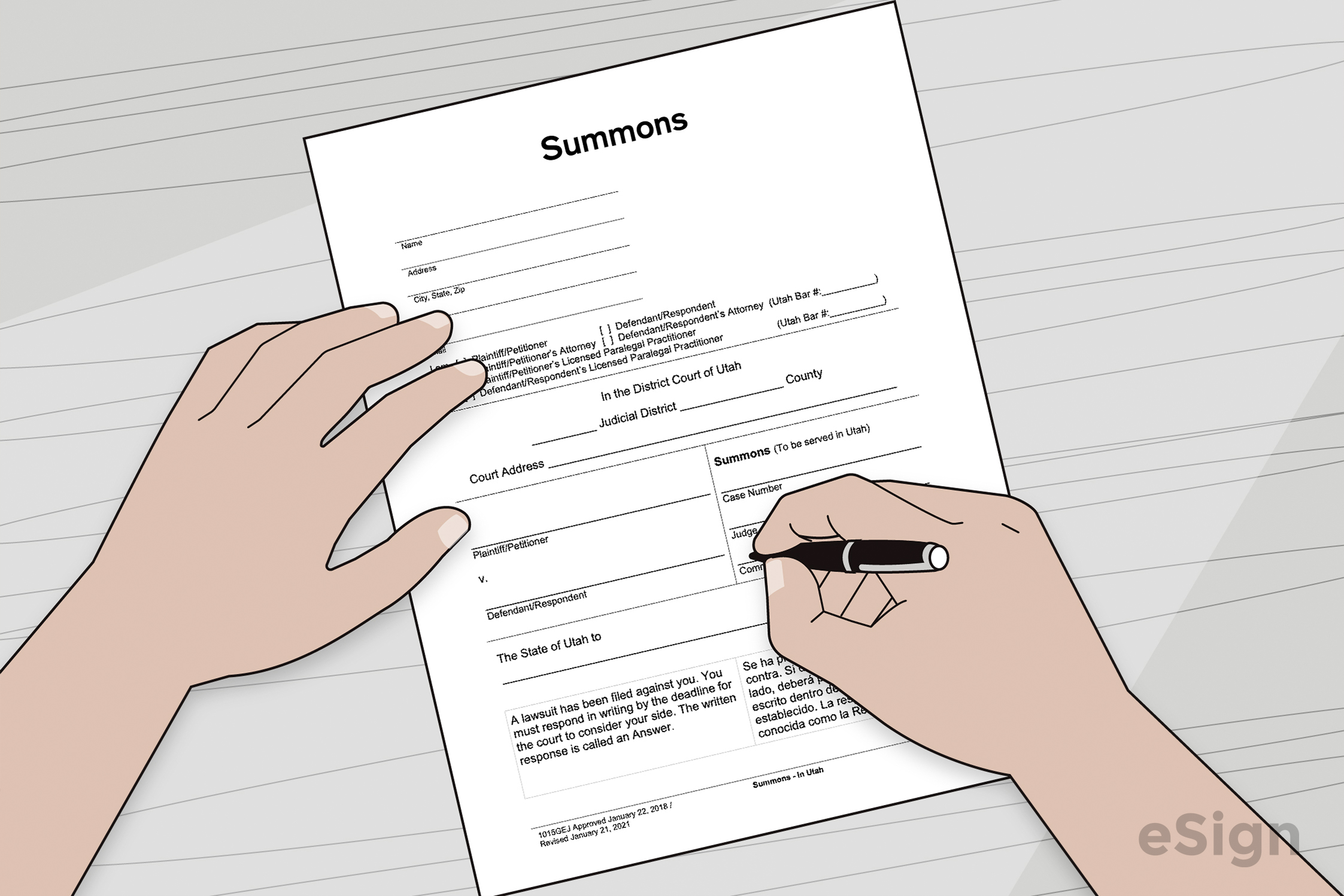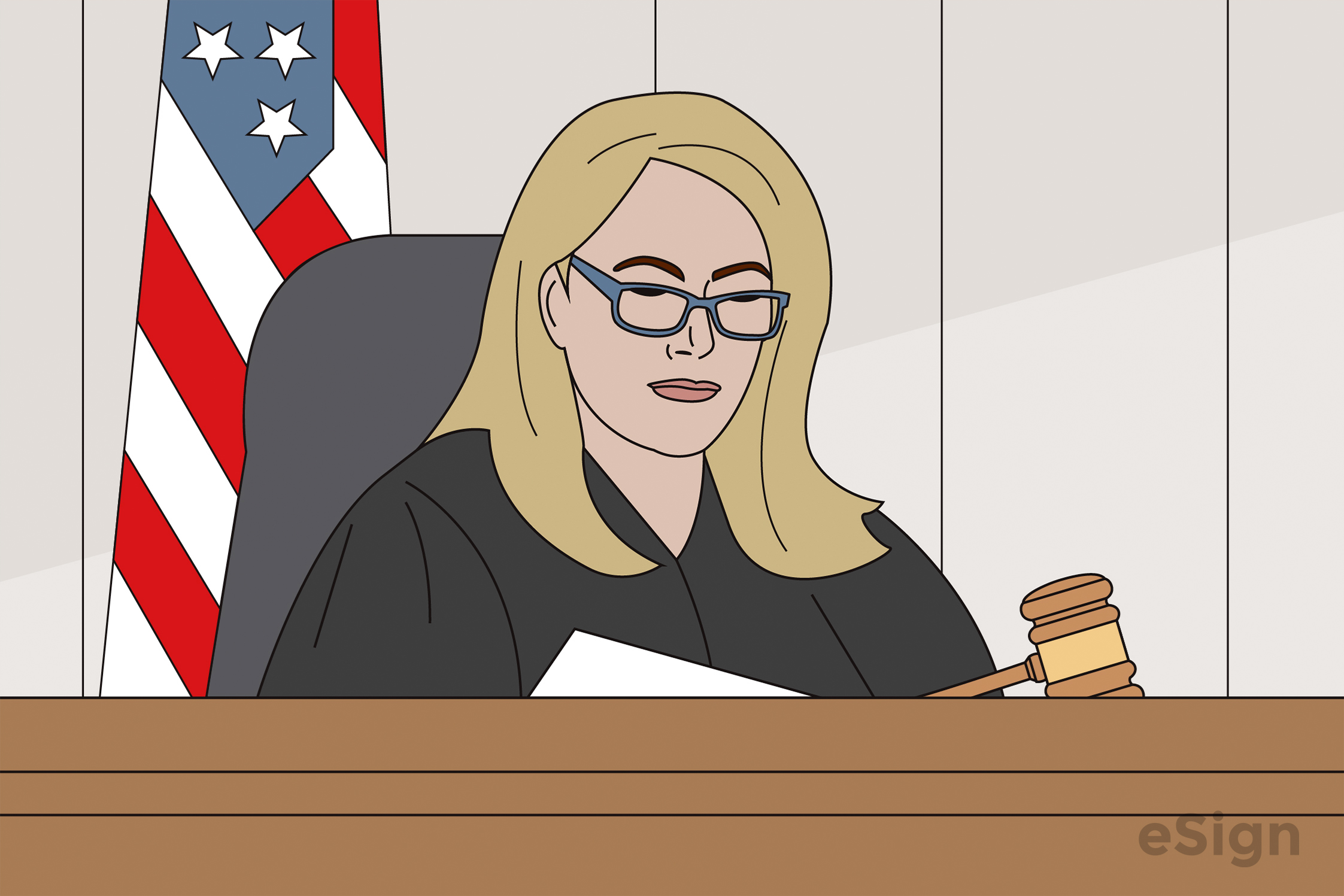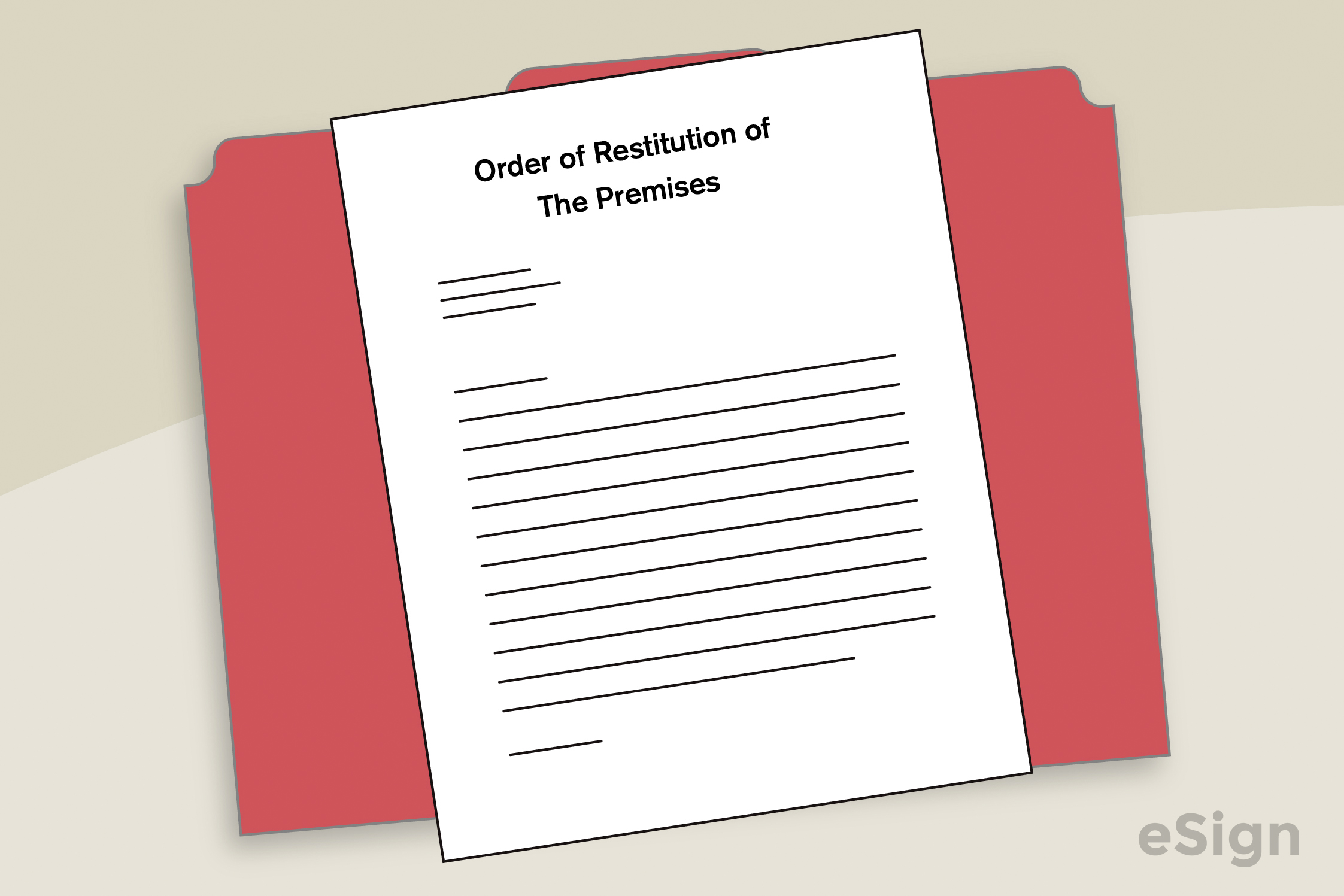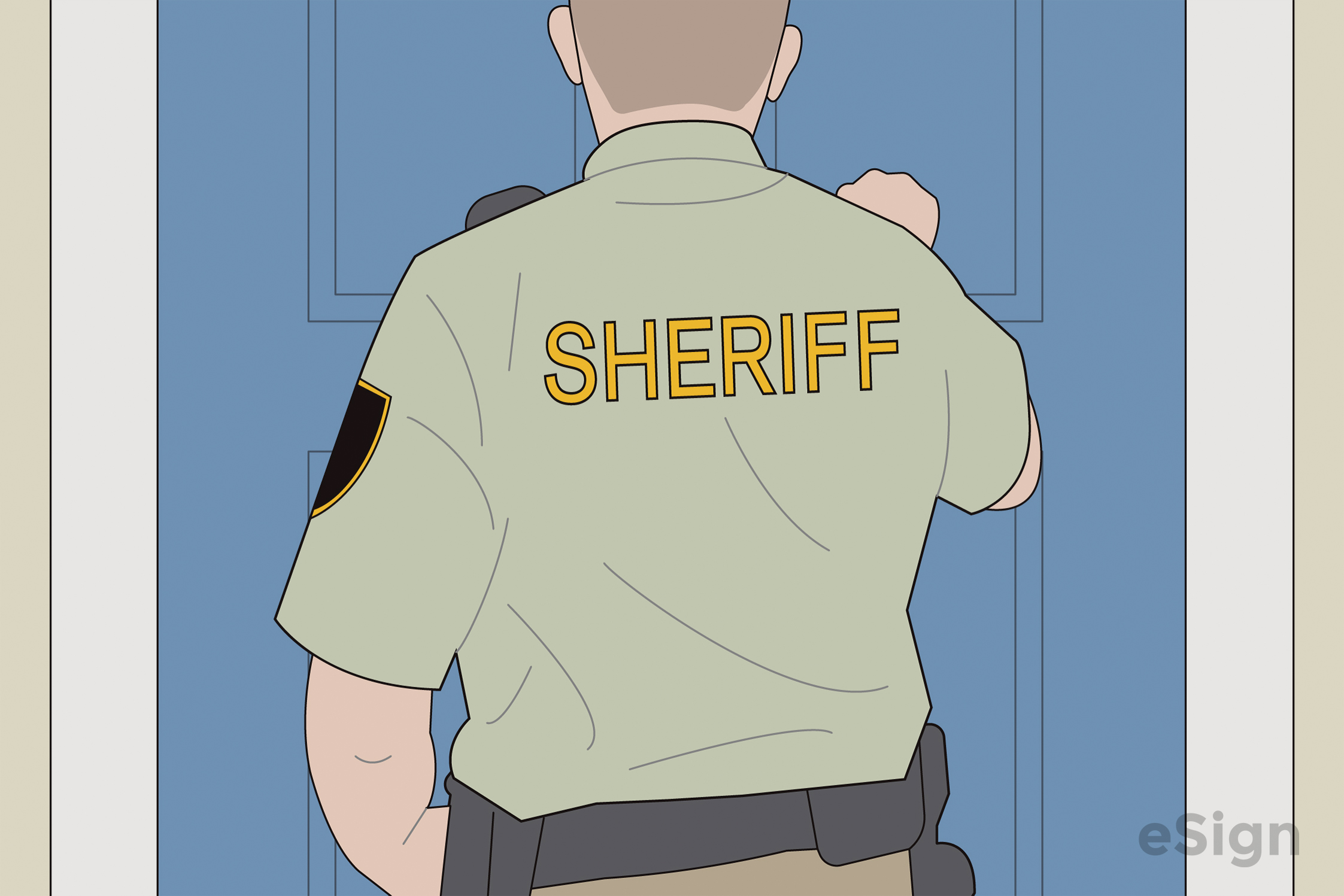Utah eviction notices are documents served on a tenant of a residential property who has violated their agreement indicating that they must vacate the premises within the number of days written on the notice. Failure on the tenant’s part to vacate before the expiration date or remedy the breach (if possible) will result in the landlord filing an eviction suit against them. Each notice will describe the reason the tenant is being asked to vacate, the amount of time they have to comply with the notice terms, and the consequences of failing to do so.
By Type (11)
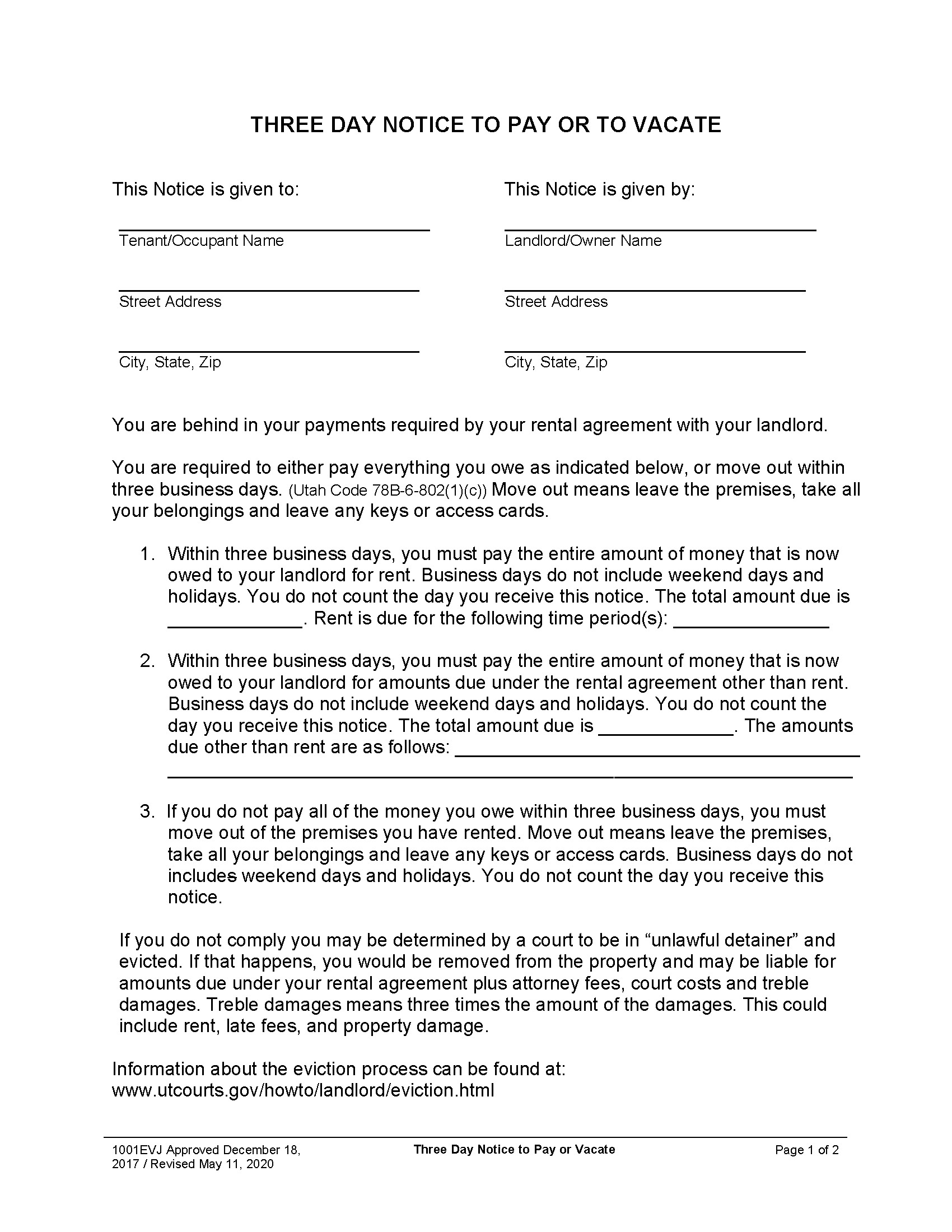 3-Day Notice to Pay or Vacate – Used to communicate to a tenant that they are in default of their rent payments and have three (3) days to pay or leave the premises.
3-Day Notice to Pay or Vacate – Used to communicate to a tenant that they are in default of their rent payments and have three (3) days to pay or leave the premises.
Download: PDF
 3-Day Notice to Comply or Vacate – A three (3) day notice to quit for the violation of the lease that gives the tenant the opportunity to remain on the premises if they remedy the breach.
3-Day Notice to Comply or Vacate – A three (3) day notice to quit for the violation of the lease that gives the tenant the opportunity to remain on the premises if they remedy the breach.
Download: PDF
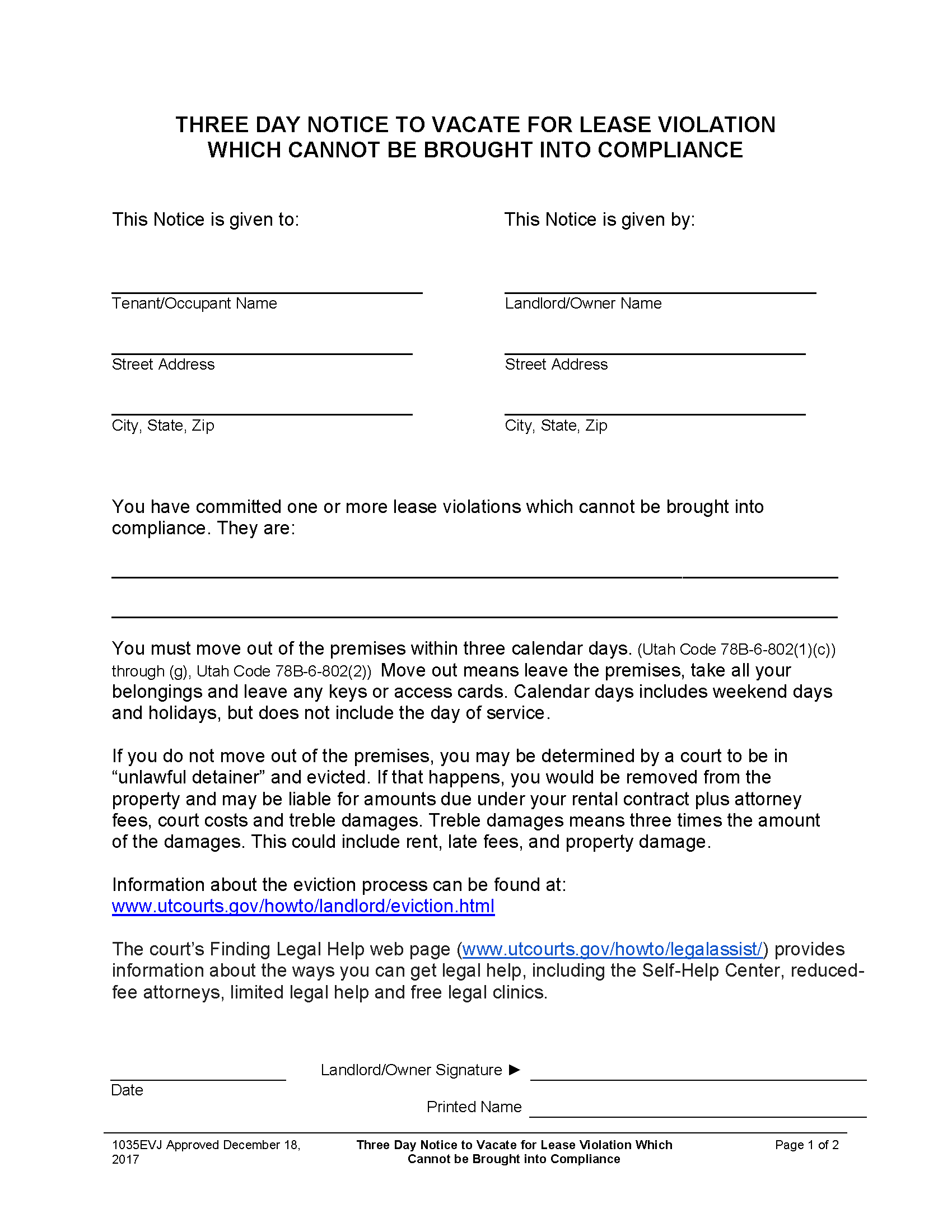
Download: PDF
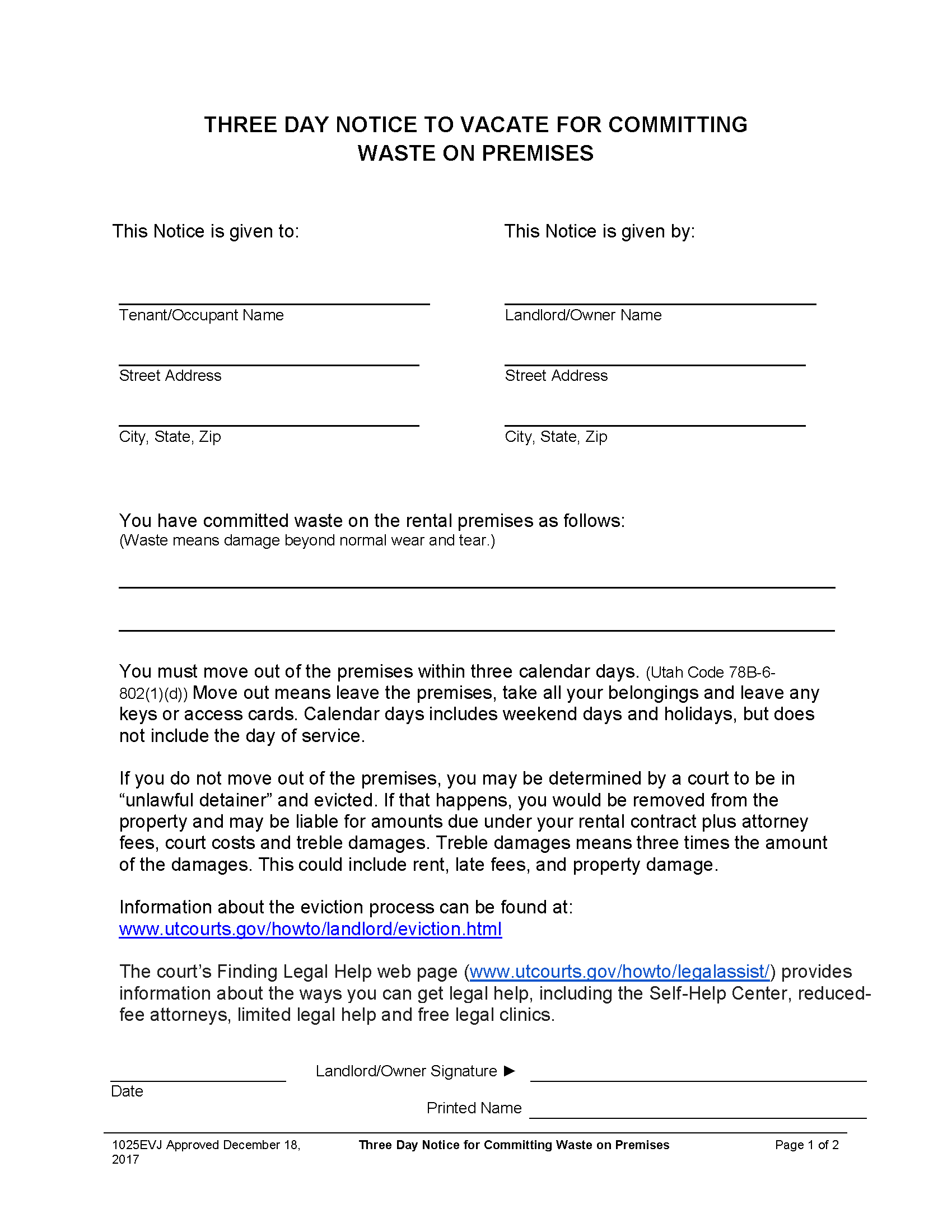
Download: PDF
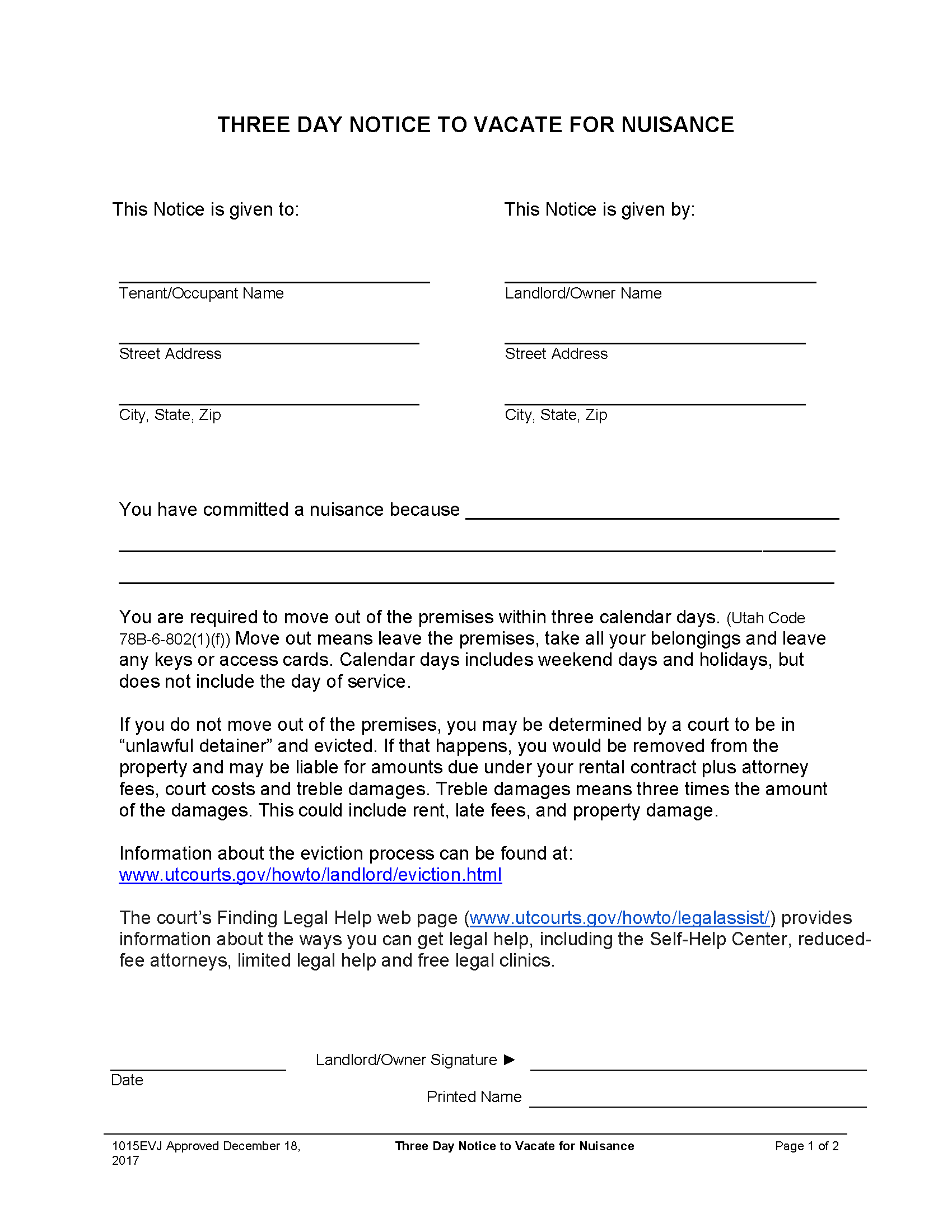
Download: PDF
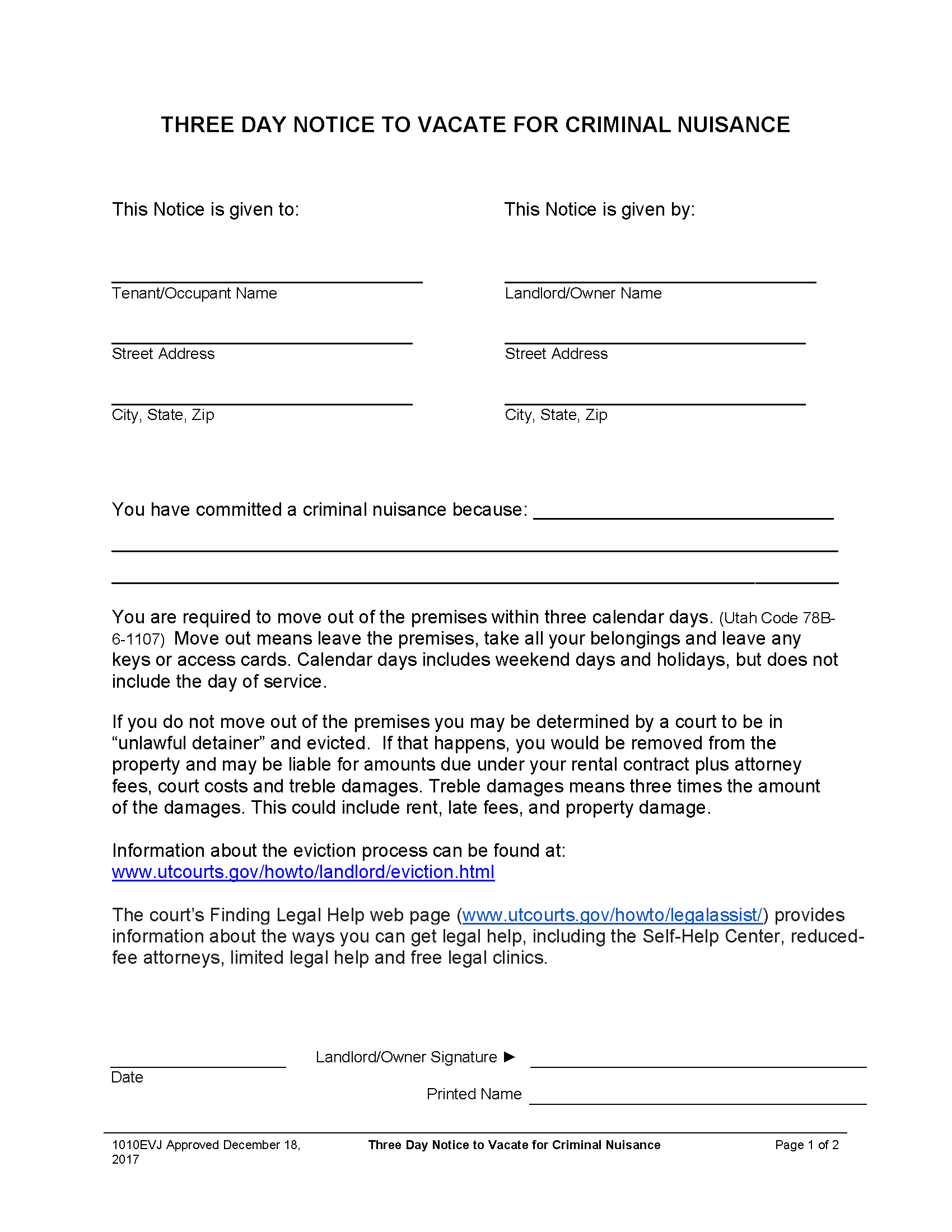
Download: PDF
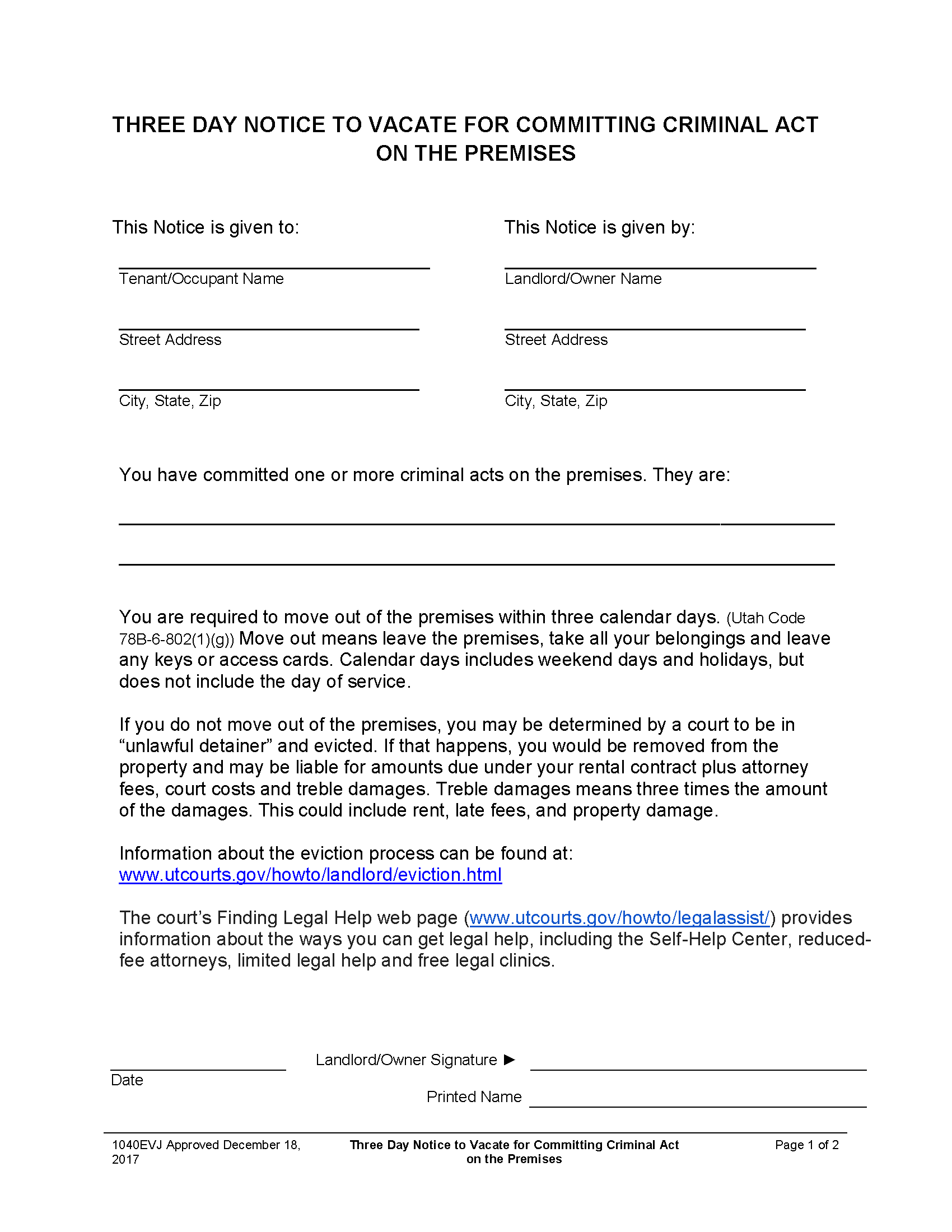
Download: PDF

Download: PDF
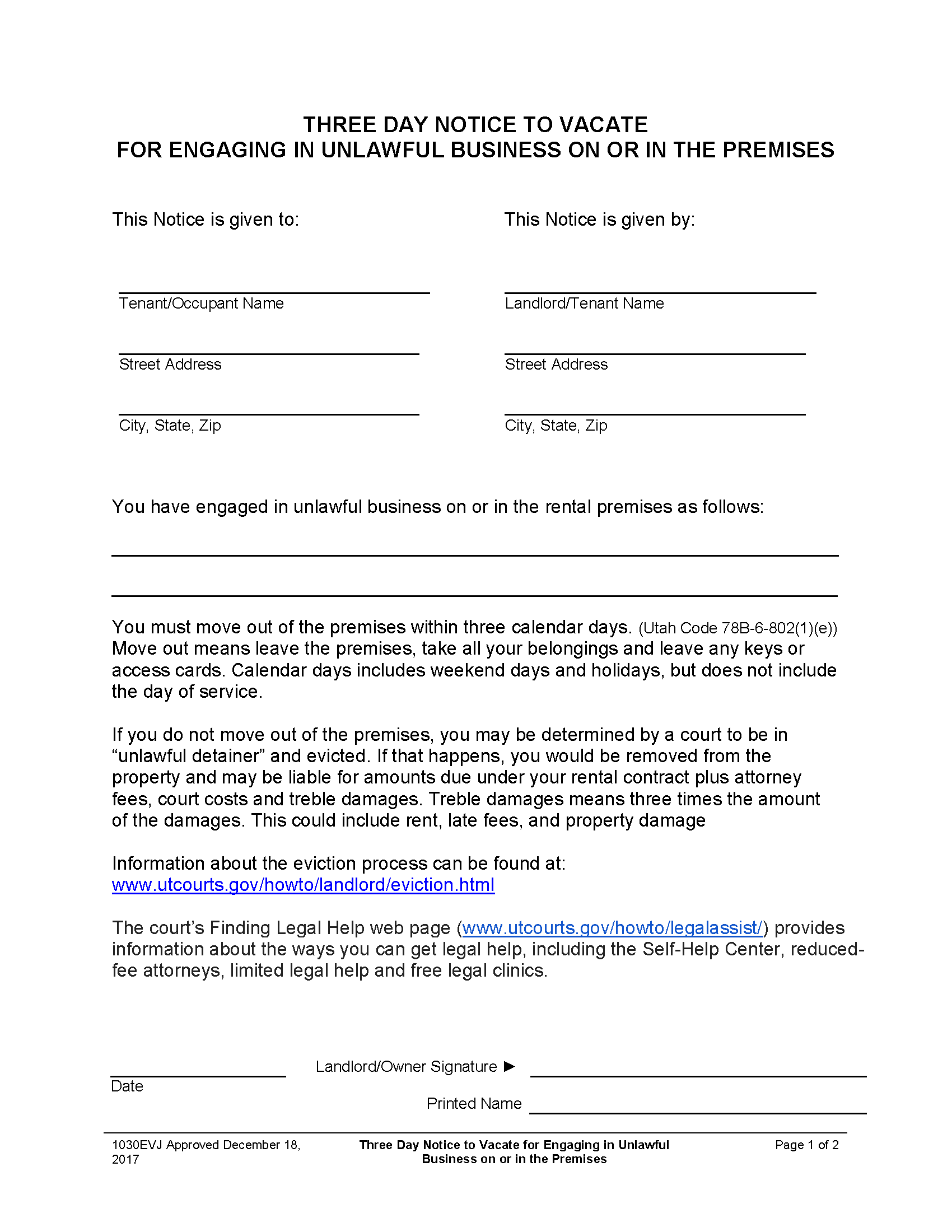
Download: PDF
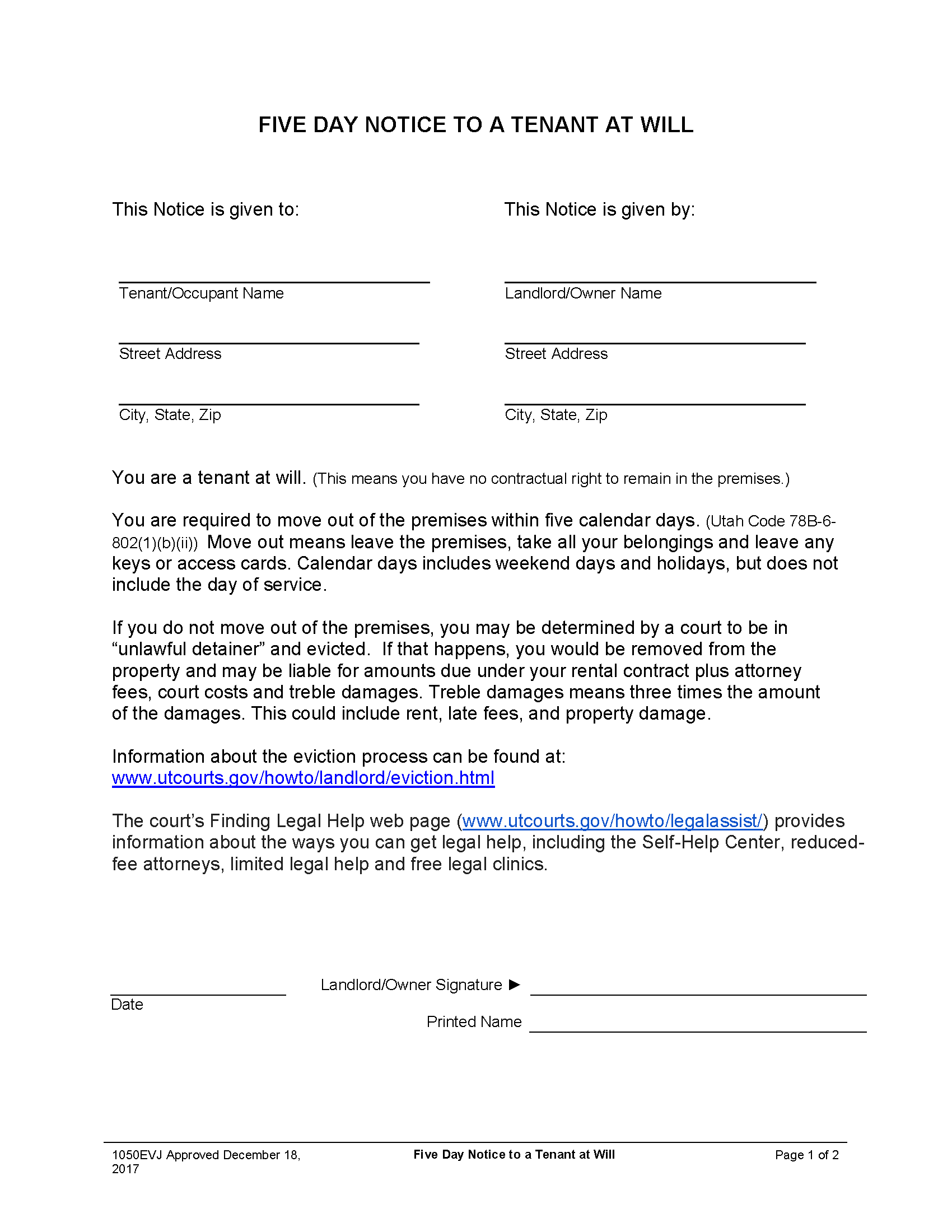
Download: PDF
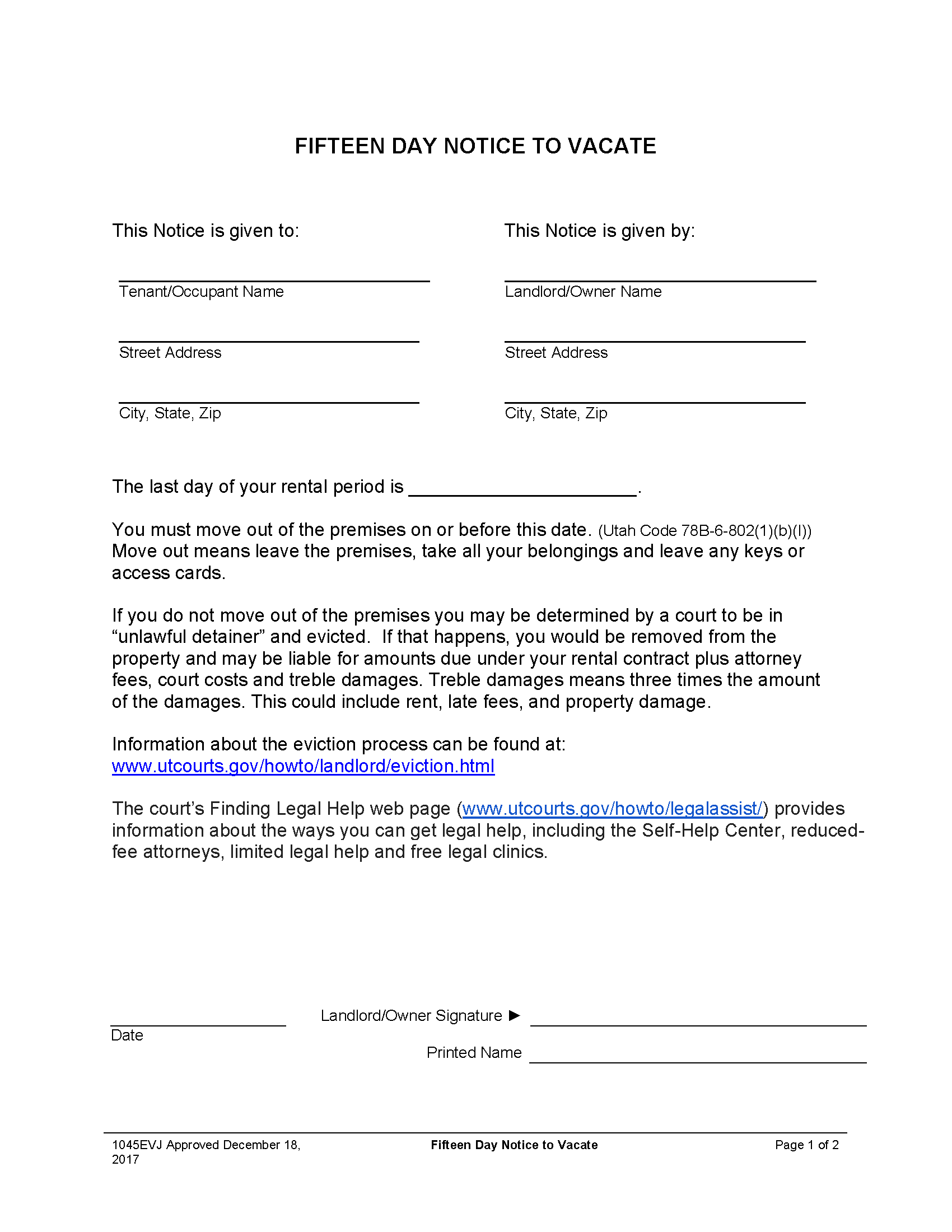
Download: PDF
Eviction Laws + Required Notices
- Grace Period: Not mentioned in state statutes.
- Non-Payment of Rent (§ 78B-6-802(1)(c)): Three (3) Days
- Lease Non-Compliance (§ 78B-6-802(1)(h) and § 78B-6-802(2)): Three (3) Days
- Nuisance/Criminal Nuisance (§ 78B-6-802(1)(f)): Three (3) Days
- Month-to-Month Tenancy Termination (§ 78B-6-802(1)(b)(i)): Fifteen (15) Days
- Vacate a Tenant At-Will (§ 78B-6-802(1)(b)(ii)): Five (5) Days
- Unlawful Business (§ 78B-6-802(1)(e)): Three (3) Days
- Criminal Act (§ 78B-6-802(1)(g)): Three (3) Days
- Damage to the Property (§ 78B-6-802(1)(d)): Three (3) Days
- Assigning or Subletting without Permission (§ 78B-6-802(1)(d)): Three (3) Days
How to Evict a Tenant
To evict a tenant in Utah, a landlord has to follow the steps set in place by the state legislature. No property owner or landlord is allowed to exclude a tenant from the property without a court order. They must have just cause to evict, provide the tenants with the appropriate notice and opportunity to vacate or remedy the problem, and serve them with the correct court forms in the correct manner in order to receive a judgment in their favor.
Step 1 – Prepare Notice to Vacate
The first step in the process of a landlord ridding themselves of a bad tenant is the preparation of a notice to quit. The Utah State government has provided forms specific to any possible infraction the tenant can commit. A landlord will have to print off the notice to vacate that corresponds with the tenant’s violation and complete it in its entirety. The complete list of notice types is as follows:
- 3-Day Notice to Pay or Vacate
- 3-Day Notice to Comply or Vacate
- 3-Day Notice for Non-Remediable Violation
- 3-Day Notice for Committing Waste
- 3-Day Notice for Nuisance
- 3-Day Notice for Criminal Nuisance
- 3-Day Notice for Criminal Act
- 3-Day Notice for Assigning or Subletting
- 3-Day Notice for Unlawful Business
- 5-Day Notice for At-Will Tenancy
- 15-Day Notice to Vacate (Lease Termination)
Step 2 – Serve Notice to Vacate
Once completed, the notice to vacate can be served on the tenant. The service can be carried out by any individual including the landlord but must be served in accordance with § 78B-6-805; that is, by doing one of the following:
- Providing the notice in person;
- Mailing it via registered or certified mail to the tenant’s residence;
- If the tenant isn’t present at the residence, leaving it with another individual of suitable age and mailing it to the tenant’s residence; or
- If none of the above is possible, affixing it to a visible place on the property.
Step 3 – Online Court Assistance Program
If the tenant remedies the issue detailed in the notice to vacate, or they vacate within the number of days indicated therein, the landlord need not go any further. However, should they fail to comply with the notice’s terms, the landlord can file an unlawful detainer suit with the district court in which the property is located to get a court order. The Utah government website provides residents with the ability to create court documents online through its Online Court Assistance Program (OCAP). Indeed, many of the necessary eviction forms are not available elsewhere. Landlords will need to create an OCAP account, complete the interview to obtain their documents, fill out their forms, and print them off to be served and filed at the courthouse.
Step 4 – Complaint and Summons
It is through the OCAP that the landlord can complete and print off the Complaint (§ 78B-6-807). The form will detail the manner in which the tenant is unlawfully detaining the property, any rent due, as well as any damages or compensation the landlord believes they’re owed. In addition to the Complaint, the landlord will also need to obtain a Summons form (also retrievable through OCAP) which will detail the time and date by which the tenant (defendant) must answer the complaint or face a default judgment.
Step 5 – Serve Complaint and Summons
Both Summons and Complaint can be filed with the district court and served on the tenant along with a copy of the eviction notice, a copy of the lease agreement, and Notice to Defendant of Disclosure Requirements in Unlawful Detainer Actions. Service must be completed by someone other than the landlord who is at least eighteen (18) years old in accordance with the Utah Rule of Civil Procedure (URCP 4). Once successfully delivered, the process server must complete a Proof of Completed Service and the landlord must file it with the court.
Step 6 – Tenant’s Answer
After receiving the Complaint and the Summons forms, the tenant will be required to file an Answer with the court within three (3) days to plead their case. This Answer must also be served on the landlord. If the tenant fails to file within the allotted time, the landlord can file a Motion for Default Judgment to obtain an Order of Restitution before even going to a hearing or trial.
Step 7 – Occupancy Hearing
If either party requests an occupancy hearing following the filing of the tenant’s Answer, the judge will set a date within ten (10) days of the filing. Both parties must serve to the other any undisclosed document to be presented at the hearing, the name and contact information of each witness, as well as the expected testimony of each witness. At the date of the hearing, the judge will hear both sides of the case and determine who will be able to occupy the property. Failure on the tenant’s part to appear will result in a default judgment against them.
Step 8 – Trial
The judge may decide that further proceedings are necessary to determine if the tenant should be permitted to remain on the premises. If this is the case, they’ll order a trial within sixty (60) days of the service of the complaint. At the trial, the judge will make a final determination as to who shall obtain occupancy. A verdict in the tenant’s favor will permit them to stay on the premises. A verdict in the landlord’s favor will have the judge issue an Order of Restitution and, if applicable, awarding the landlord any unpaid rent before and after the complaint. They may also demand that the tenant pay the landlord’s attorneys’ fees as well as three (3) times the cost of any damages resulting from the eviction process or reason for eviction (waste of premises, abatement of nuisance).
Step 9 – Order of Restitution of the Premises
Signing the Order of Restitution of the Premises will direct law enforcement to serve the document on the tenant in the same manner that the notice to vacate was delivered. The Order will direct the tenant that they have three (3) days to move out or they will be physically removed from the premises. The tenant should also receive a Request for Hearing Regarding Enforcement of an Order of Restitution which enables them to object to the manner in which the Order for Restitution was enforced. The filing of the request will not delay or stop the Order of Restitution unless the court agrees to it after the tenant has posted bond.
Step 10 – Removal
If the tenant remains on the premises beyond the three (3) days allotted to them, a sheriff or constable will be permitted to enter the property and physically remove them and their belongings. Their possessions will be kept in storage until the tenant has paid the storage costs although the tenant may retrieve certain essential items such as clothing and identification within five (5) calendar days.
Court Forms + Resources
Court Forms
- Summons
- Signing: Plaintiff (Landlord)
- Answer
- Signing: Defendant (Tenant)
- Motion for Default Judgment
- Signing: Judge
- Order of Restitution
- Signing: Judge
- Objection to Form of Order
- Signing: Defendant (Tenant)
- Notice to Defendant of Disclosure Requirements in Unlawful Detainer Actions
- Signing: Plaintiff (Landlord)
- Request for Hearing Regarding Enforcement of an Order of Restitution
- Signing: Defendant (Tenant)

